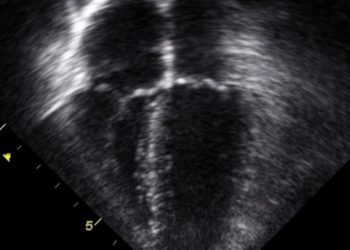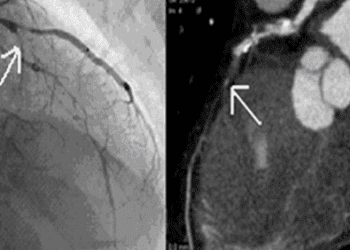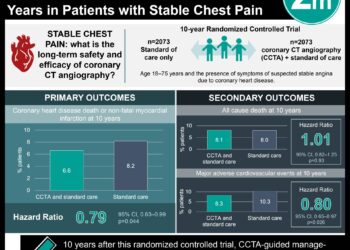Deep neural networks trained to estimate reduced left ventricular ejection fraction from adult angiogram videos of left coronary artery
1. In this cross-sectional study, among 4042 adult angiograms matched with 3679 corresponding transthoracic echocardiograms (TTE), a video-based deep neural network was trained to estimate reduced left ventricular ejection fraction (LVEF) with an area under the receiver operating characteristic curve of 0.911.
2. The video-based DNN (CathEF) tended to overestimate low LVEFs and underestimate high LVEFs.
Evidence Rating Level: 2 (Good)
Study Rundown: Coronary artery disease (CAD) is a leading cause of death worldwide. For patients living with CAD, coronary angiography is the gold-standard assessment to inform clinical decision-making, including medical and surgical options. LVEF is critical to assess with coronary angiography as it can affect procedural decisions and patient treatment. This cross-sectional study aimed to develop an automated approach to predict LVEF from left coronary angiograms. In terms of exposures, a video-based deep neural network (DNN) called CathEF was used to discriminate reduced LVEF (≤ 40%) and to predict LVEF percentage from angiogram videos of the left coronary artery. Using a total of 4042 adult coronary angiograms matched with corresponding TTE LVEFs from 3679 patients from the University of California, San Francisco (UCSF), a DNN was trained to estimate reduced LVEF and continuous LVEF. In the UCSF data set, the video-based DNN was able to discriminate reduced LVEF with an area under the receiver operating characteristic curve (AUROC) of 0.911. DNN-predicted continuous LVEF had a mean absolute error (MAE) of 8.5% compared to TTE LVEF. Video-based DNN, however, was found to overestimate low LVEFs and underestimate high LVEFs. A major strength of this study is the large sample size. A limitation, however, is that the video-based DNN tended to underestimate high LVEF values (> 65%) and overestimate severely reduced LVEF values (≤ 30%). Hence, caution is required when interpreting DNN predictions. Overall, this study demonstrates the potential of estimating LVEF from standard angiogram videos of the left coronary artery using video-based DNNs.
Click to read the study in JAMA Cardiology
Relevant Reading: A deep learning approach for assessment of regional wall motion abnormality from echocardiographic images
In-Depth [cross-sectional study]: This study aimed to develop an automated approach to predict LVEF from coronary angiograms. This study was externally validated using data from 3679 patients from the UCSF from 2012 to 2019. External validation data was also obtained from the University of Ottawa Heart Institute. A total of 4042 adult angiograms with corresponding TTE LVEF from 3679 UCSF patients were included in the analysis (mean [SD] age, 64.3 [13.3] years, 65% male patients). A video-based DNN called CathEF was used to discriminate reduced LVEF (≤ 40%) and to predict continuous LVEF from standard angiogram videos of the left coronary artery. In the UCSF data set (n=813), the video-based DNN was able to discriminate reduced LVEF with an AUROC of 0.911 (95% CI, 0.887 – 0.934); the diagnostic odds ratio for reduced LVEF was 22.7 (95% CI, 14.0 – 37.0). DNN-predicted continuous LVEF was found to have a MAE of 8.5% (95% CI, 8.1% – 9.0%) when compared with TTE LVEF. Despite DNN-predicted continuous LVEF differing by 5% or less compared with TTE LVEF in approximately 38% of test data set studies, differences greater than 15% were observed in 15.2%. Further, in external validation (n=776), video-based DNN discriminated reduced LVEF with an AUROC of 0.906 (95% CI, 0.881 – 0.931), and DNN-predicted continuous LVEF had a MAE of 7.0% (95% CI, 6.6% – 7.4%).
Image: PD
©2023 2 Minute Medicine, Inc. All rights reserved. No works may be reproduced without expressed written consent from 2 Minute Medicine, Inc. Inquire about licensing here. No article should be construed as medical advice and is not intended as such by the authors or by 2 Minute Medicine, Inc.




![PFO closure equivalent to medical management in prevention of recurrent stroke [PC and RESPECT trials]](https://www.2minutemedicine.com/wp-content/uploads/2013/03/Echokardiogram_von_Atriumseptumdefekt_Ostium_secundum1-350x250.jpg)




